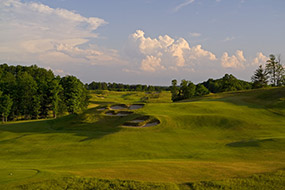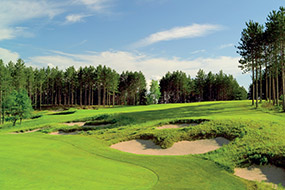Located an hour east of Crystal Downs, the Kingsley Club was the first solo design project for architect Mike DeVries, who spent much of his youth at the Downs and even worked on the grounds crew for a number of years studying the elements that made the course so special. DeVries had previously worked for Tom Fazio and Tom Doak, but his selection as lead architect for this project was a big gamble. It took an endorsement from the head professional at Crystal Downs to convince the club owners of his suitability.
The young designer did not disappoint, recognizing the opportunity he had been given and working tirelessly to create a course that could stand proudly among Michigan’s finest. Just like at Crystal Downs, the front nine here is dominated by sparse rolling duneland and the back nine is carved through steeper hills and mature hardwoods. By shaping his bunkers with rugged edges and locating his greens in a range of natural settings, such as in saddles and punchbowls or atop crests and into hills, the designer was able to massage the terrain into a classically styled golf course without moving much earth.
There is a great balance to the routing, although the more expansive undulations of the opening nine give it slightly more appeal. The round begins with an interesting split-level par five, central traps creating an upper and lower fairway and distinct routes into the distant green. The 2nd is an outstanding short par three, played along a ridge to a narrow, semiconcealed green that falls sharply into bunkers. Among the other memorable holes are mid-length par fours at the 4th, 6th and 8th. The 4th features a wild fairway but its best noted for a massive basin green set beyond a small berm. Heading first over a large bunkered ridge the 6th plays into a wonderful target situated on a natural shelf between two hills. The 8th is the most strategic; aggressive golfers can flirt with the right rough and a large central bunker in order to set up the best pitch into a small ledge green.
The back nine is also first-rate, the holes more heavily treed and also more undulating. Particularly impressive are gems like the driveable par four 13th, which offers countless options of attack and one of the most bizarre greens in the Midwest, the target more than 12,000 square feet in size, almost 60 yards long and with a pronounced dip through its middle. The par three 16th is another beautiful hole, the green set within a gentle right-to-left slope that allows you to chase a ball off the right side or play a more aggressive fade shot. Less receptive is the 15th, which is the longest par four on the course but with the smallest green, its target precariously raised several feet above the fairway and tucked into the base of a hill.
Although there are a couple of problem spots at Kingsley, the architect’s inclination to leave the ground contours alone–even the severe ones–has paid dividends, because the entire layout fits nicely into the terrain. Pleasingly, the club keeps the bumpy course firm and fast, which ensures the holes remain both challenging and fun to play. This was a remarkable opportunity for someone starting out in the design business, and DeVries has since gone onto bigger and better things. One suspects, however, that given this was his first full project and built close to his hometown, that Kingsley retains a very special place in his affections.

 this course also has exceptional:
this course also has exceptional:

